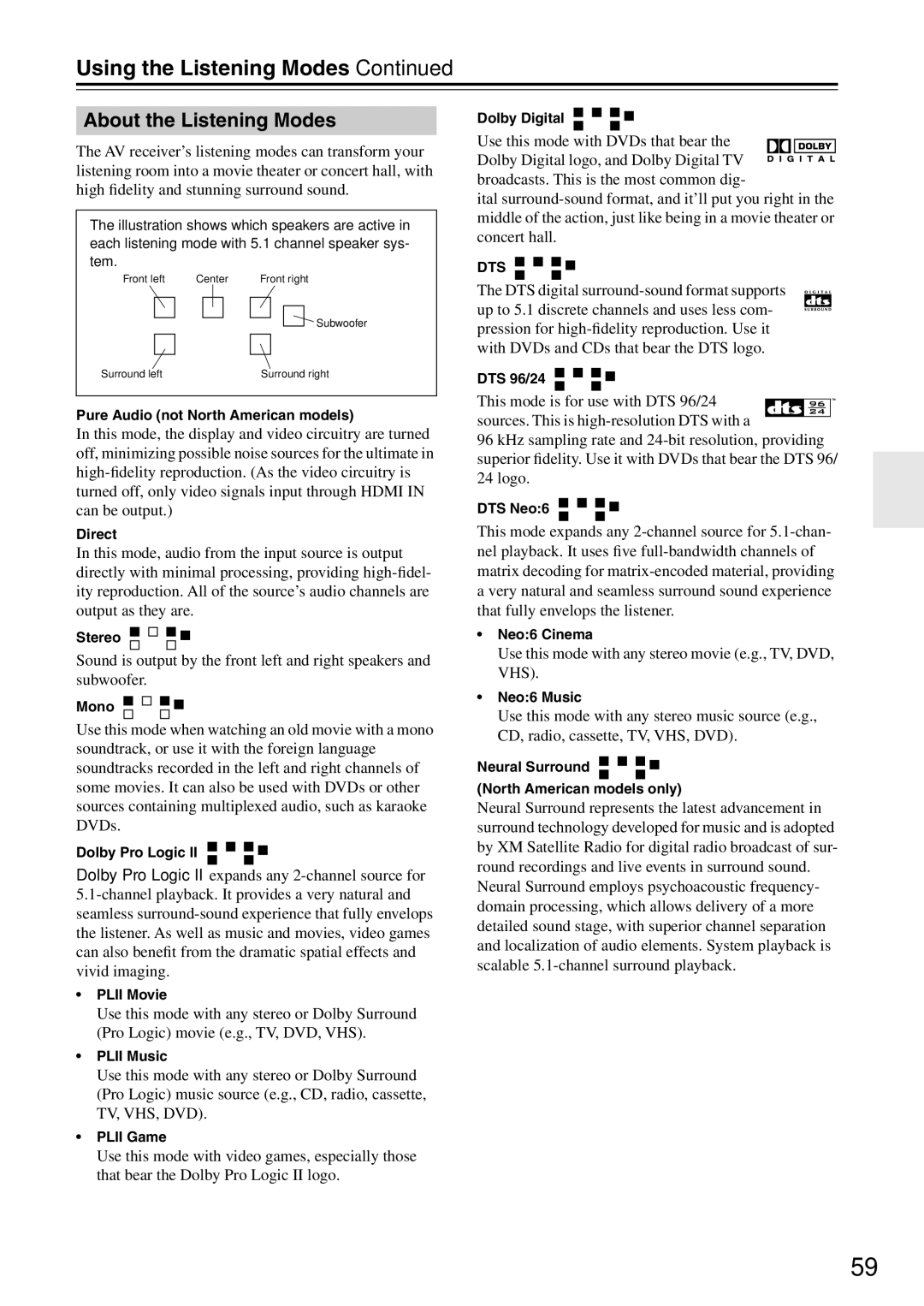HT-R640
Avis
Important Safety Instructions
FCC Information for User
Precautions
Power
For models having a power cord with a polarized plug
Speaker cable labels Not North American models Hdmi cable
Supplied Accessories
Precautions
Make sure you have the following accessories
FM/AM/XM Tuner
Features
Amplifier
Audio/Video
Table of Contents
Front Panel
Front & Rear Panels
Front & Rear Panels
Display
Hdmi in 1, 2, and OUT
Rear Panel
Digital Optical in 1, 2, 3 and OUT
XM antenna on North American models
Tape IN/OUT
Aiming the Remote Controller
Remote Controller
Installing the Batteries
RECEIVER/AMP/TAPE Mode or AMP/TAPE Mode
Remote Controller
Using the Remote Controller
Multi CH button
Remote Mode buttons
Buttons used when the Tuner input is selected
Buttons used when the Tape input is selected
DVD Mode
Arrow Enter buttons
CD/MD/CDR/HDD Mode
To select the input source, press
DISC/ALBUM +/- button
Enjoying Home Theater
About Home Theater
AV Connection Color Coding
Connecting the AV Receiver
About AV Connections
Optical Digital Jacks
Connecting Your Speakers
Connecting the AV Receiver
Strip about 5/8 15 mm
Speaker Connection Precautions
Connecting the Speaker Cables
Attach the FM antenna, as shown North American models
Connecting Antenna
Connecting the Indoor FM Antenna
Connecting the AM Loop Antenna
Using a TV/FM Antenna Splitter
Connecting an Outdoor FM Antenna
Connecting an Outdoor AM Antenna
Audio Connection Formats
Connecting Both Audio & Video
Which Connections Should I Use?
Video Connection Formats
Hint
Connecting Your TV or Projector
Video Connection
Audio Connection
Connecting a DVD Player
DVD player
Hooking Up the Multichannel DVD Input
DVD recorder
Connecting a VCR or DVD Recorder for Playback
Connecting a VCR or DVD Recorder for Recording
Satellite, cable, set-top box, etc
Connecting a Camcorder, Games Console, or Other Device
About Copyright Protection
Connecting Components with Hdmi
About Hdmi
Supported Audio Formats
Making Hdmi Connections
Video Signal Flow Chart
Audio Signal Flow Chart
Phono Preamp MC head amp or MC transformer
Connecting a CD Player or Turntable
CD Player or Turntable MM with Built-in Phono Preamp Step
For HDD-compatible components that don’t support video
Connecting a HDD-compatible Component
For HDD-compatible components that support video
Connecting a Cassette, CDR, MiniDisc, or DAT Recorder
Remote Control
Connecting Onkyo Components
Connecting the Power Cord of Another Component
Auto Power On/Standby
Smooth Operation in a Few Easy Steps
Connecting the Power Cord
Turning On the AV Receiver
Turning On and Standby
Main menu
First Time Setup
About the Onscreen Setup Menus
Submenus
Digital Input
First Time Setup
Video Input
Hdmi Video Setup
Connected to Compo
Component Video Setup
Video 4 is fixed to
IN1 Use the video component
Speaker Config menu appears
Speaker Configuration
Double Bass
Testing the Speakers
Press the remote controller’s Test Tone but- ton
Low-Pass Filter for the LFE Channel
Changing the Input Display
TV Format Setup Not North American models
Video OUT, Hdmi OUT or Monitor OUT
Basic Operations
Selecting the Input Source
Start playback on the source component
Displaying Source Information
Using the Multichannel DVD Input
Adjusting the Bass & Treble
Basic Operations
Muting the AV Receiver
Using the Sleep Timer
Setting the Display Brightness
Using Headphones
Listening to the Radio
Using the Tuner
Tuning into Radio Stations
Listening to the Radio
Listening to the Radio
Presetting AM/FM Stations XM Channels
Selecting Presets
Deleting Presets
RDS Program Types PTY
Using RDS European models only
What is RDS?
Finding Stations by Type PTY
Displaying Radio Text RT
Listening to Traffic News TP
About XM Radio
Connecting the XM Passport System
Listening to XM Satellite Radio North American models only
Important XM Radio Information
Selecting XM Satellite Radio
Setting the Satellite Radio Mode
Signing Up for XM Satellite Radio
Followed by the D TUN button
Channel Search mode select any channel
Selecting XM Radio Channels
Press the Receiver button
Displaying XM Radio Information
Positioning the XM Passport System
XM Radio Messages
Selecting on the AV Receiver
Using the Listening Modes
Selecting with the Remote Controller
Selecting Listening Modes
PCM
Using the Listening Modes
About the Listening Modes
Use this mode with any stereo movie e.g., TV, DVD, VHS
Onkyo Original DSP Modes
Recording Separate AV Sources
Recording
AV Recording
Using the Audyssey EQ North American models only
Using the CinemaFILTER
Using the Late Night Function Dolby Digital only
Adjusting Individual Speaker Levels
Tance, and then press Enter
Advanced Setup
Advanced Speaker Settings
Speaker Distance
Test tone from each speaker
Advanced Setup
Repeat until the volume
Speaker Level Calibration
SW Input Sensitivity
Multichannel DVD Input Settings
Audio Adjust Functions
When you’ve finished, press
Listening Setting
Input Channel Settings
PL II Music Mode Settings
Neo6 Music Mode Setting
Select the input source that you
Tons on the remote controller to
Assigning Listening Modes to Input Sources
Use the Input Selector but
Miscellaneous Setup,
IntelliVolume
Volume Setup/OSD Setup
Use the Up and Down Buttons to select a. IntelliVolume
Hdmi Audio Out
Changing the AV Receiver’s ID
TAL Input button for about 3 seconds
Lock Setup
Digital Input Signal Formats
Press and hold the AV receiver’s Digi
Receiver or AMP button lights up
Changing the Remote Controller’s ID
Correcting Sound and Picture Sync
Controlling Other Components
Entering Remote Control Codes
Controlling Other Components
Remote Control Codes for Onkyo Components Connected via
Resetting Remote Mode Buttons
Resetting the Remote Controller
CH +
TV VOL
Tuner Section
Specifications
Amplifier Section
Video Section
Troubleshooting
Troubleshooting
Can’t record
Remote controller doesn’t work
Sound changes when I connect my head- phones
Can’t control other components
Video ATT2 Gain is reduced by 2 dB
Video ATT0 default
Video Attenuation
Onkyo Europe UK Office
Onkyo Europe Electronics GmbH

